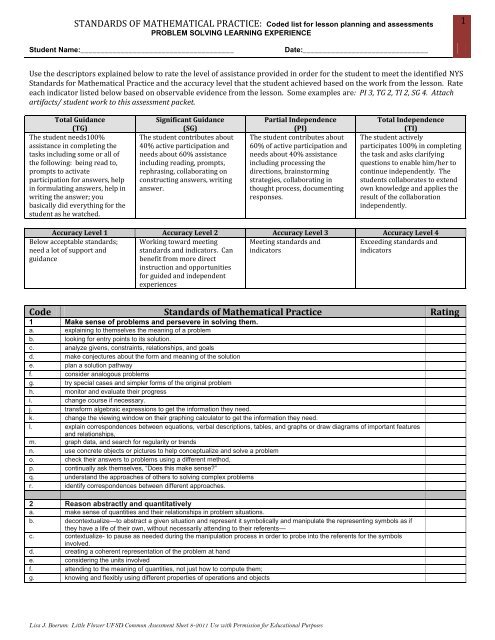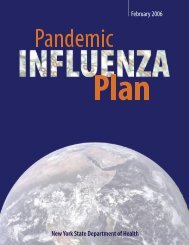STANDARDS OF MATHEMATICAL PRACTICE: Coded list for lesson
STANDARDS OF MATHEMATICAL PRACTICE: Coded list for lesson
STANDARDS OF MATHEMATICAL PRACTICE: Coded list for lesson
You also want an ePaper? Increase the reach of your titles
YUMPU automatically turns print PDFs into web optimized ePapers that Google loves.
<strong>STANDARDS</strong> <strong>OF</strong> <strong>MATHEMATICAL</strong> <strong>PRACTICE</strong>: <strong>Coded</strong> <strong>list</strong> <strong>for</strong> <strong>lesson</strong> planning and assessments<br />
PROBLEM SOLVING LEARNING EXPERIENCE<br />
1<br />
Student Name:______________________________________<br />
Date:_______________________________<br />
Use the descriptors explained below to rate the level of assistance provided in order <strong>for</strong> the student to meet the identified NYS<br />
Standards <strong>for</strong> Mathematical Practice and the accuracy level that the student achieved based on the work from the <strong>lesson</strong>. Rate<br />
each indicator <strong>list</strong>ed below based on observable evidence from the <strong>lesson</strong>. Some examples are: PI 3, TG 2, TI 2, SG 4. Attach<br />
artifacts/ student work to this assessment packet.<br />
Total Guidance<br />
(TG)<br />
The student needs100%<br />
assistance in completing the<br />
tasks including some or all of<br />
the following: being read to,<br />
prompts to activate<br />
participation <strong>for</strong> answers, help<br />
in <strong>for</strong>mulating answers, help in<br />
writing the answer; you<br />
basically did everything <strong>for</strong> the<br />
student as he watched.<br />
Significant Guidance<br />
(SG)<br />
The student contributes about<br />
40% active participation and<br />
needs about 60% assistance<br />
including reading, prompts,<br />
rephrasing, collaborating on<br />
constructing answers, writing<br />
answer.<br />
Partial Independence<br />
(PI)<br />
The student contributes about<br />
60% of active participation and<br />
needs about 40% assistance<br />
including processing the<br />
directions, brainstorming<br />
strategies, collaborating in<br />
thought process, documenting<br />
responses.<br />
Total Independence<br />
(TI)<br />
The student actively<br />
participates 100% in completing<br />
the task and asks clarifying<br />
questions to enable him/her to<br />
continue independently. The<br />
students collaborates to extend<br />
own knowledge and applies the<br />
result of the collaboration<br />
independently.<br />
Accuracy Level 1 Accuracy Level 2 Accuracy Level 3 Accuracy Level 4<br />
Below acceptable standards;<br />
need a lot of support and<br />
guidance<br />
Working toward meeting<br />
standards and indicators. Can<br />
benefit from more direct<br />
instruction and opportunities<br />
<strong>for</strong> guided and independent<br />
experiences<br />
Meeting standards and<br />
indicators<br />
Exceeding standards and<br />
indicators<br />
Code Standards of Mathematical Practice Rating<br />
1 Make sense of problems and persevere in solving them.<br />
a. explaining to themselves the meaning of a problem<br />
b. looking <strong>for</strong> entry points to its solution.<br />
c. analyze givens, constraints, relationships, and goals<br />
d. make conjectures about the <strong>for</strong>m and meaning of the solution<br />
e. plan a solution pathway<br />
f. consider analogous problems<br />
g. try special cases and simpler <strong>for</strong>ms of the original problem<br />
h. monitor and evaluate their progress<br />
i. change course if necessary.<br />
j. trans<strong>for</strong>m algebraic expressions to get the in<strong>for</strong>mation they need.<br />
k. change the viewing window on their graphing calculator to get the in<strong>for</strong>mation they need.<br />
l. explain correspondences between equations, verbal descriptions, tables, and graphs or draw diagrams of important features<br />
and relationships,<br />
m. graph data, and search <strong>for</strong> regularity or trends<br />
n. use concrete objects or pictures to help conceptualize and solve a problem<br />
o. check their answers to problems using a different method,<br />
p. continually ask themselves, ―Does this make sense?‖<br />
q. understand the approaches of others to solving complex problems<br />
r. identify correspondences between different approaches.<br />
2 Reason abstractly and quantitatively<br />
a. make sense of quantities and their relationships in problem situations.<br />
b. decontextualize—to abstract a given situation and represent it symbolically and manipulate the representing symbols as if<br />
they have a life of their own, without necessarily attending to their referents—<br />
c. contextualize- to pause as needed during the manipulation process in order to probe into the referents <strong>for</strong> the symbols<br />
involved.<br />
d. creating a coherent representation of the problem at hand<br />
e. considering the units involved<br />
f. attending to the meaning of quantities, not just how to compute them;<br />
g. knowing and flexibly using different properties of operations and objects<br />
Lisa J. Boerum: Little Flower UFSD Common Assessment Sheet 8-2011 Use with Permission <strong>for</strong> Educational Purposes
<strong>STANDARDS</strong> <strong>OF</strong> <strong>MATHEMATICAL</strong> <strong>PRACTICE</strong>: <strong>Coded</strong> <strong>list</strong> <strong>for</strong> <strong>lesson</strong> planning and assessments<br />
PROBLEM SOLVING LEARNING EXPERIENCE<br />
2<br />
Student Name:______________________________________<br />
Date:_______________________________<br />
Code Standards of Mathematical Practice Rating<br />
3 Construct viable arguments and critique the reasoning of others.<br />
a. understand and use stated assumptions, definitions, and previously established results in constructing arguments.<br />
b. make conjectures and build a logical progression of statements to explore the truth of their conjectures.<br />
c. analyze situations by breaking them into cases, and can recognize and use counterexamples<br />
d. justify their conclusions<br />
e. communicate their conclusions to others<br />
f. respond to the arguments of others.<br />
g. reason inductively about data<br />
h. make plausible arguments that take into account the context from which the data arose.<br />
i. compare the effectiveness of two plausible arguments,<br />
j. distinguish correct logic or reasoning from that which is flawed, and—if there is a flaw in an argument—explain what it is.<br />
k. construct arguments using concrete referents such as objects, drawings, diagrams, and actions<br />
l. determine domains to which an argument applies.<br />
m. <strong>list</strong>en or read the arguments of others, decide whether they make sense<br />
n. ask useful questions to clarify or improve the arguments.<br />
4 Model with mathematics<br />
a. apply the mathematics they know to solve problems arising in everyday life, society, and the workplace.<br />
In early grades, this might be as simple as writing an addition equation to describe a situation.<br />
In middle grades, a student might apply proportional reasoning to plan a school event or analyze a problem in the<br />
community.<br />
By high school, a student might use geometry to solve a design problem or use a function to describe how one<br />
quantity of interest depends on another.<br />
b. make assumptions and approximations to simplify a complicated situation, realizing that these may need revision later<br />
c. identify important quantities in a practical situation and map their relationships using such tools as diagrams, two-way tables,<br />
graphs, flowcharts and <strong>for</strong>mulas.<br />
d. analyze those relationships mathematically to draw conclusions.<br />
e. interpret their mathematical results in the context of the situation and reflect on whether the results make sense,<br />
f. improve the model if it has not served its purpose.<br />
5 Use appropriate tools strategically.<br />
a. consider the available tools when solving a mathematical problem.<br />
These tools might include pencil and paper, concrete models, a ruler, a protractor, a calculator, a spreadsheet, a<br />
computer, algebra system, a statistical package, or dynamic geometry software.<br />
b. are familiar with tools appropriate <strong>for</strong> their grade or course to make sound decisions about when each of these tools might<br />
be helpful<br />
c. recognize both the insight to be gained and the limitations of the available tools.<br />
high school students analyze graphs of functions and solutions generated using a graphing calculator.<br />
d. detect possible errors by strategically using estimation and other mathematical knowledge<br />
e. make mathematical models<br />
f. use technology to visualize the results of varying assumptions, explore consequences, and compare predictions with data.<br />
g. identify relevant external mathematical resources, such as digital content located on a website, and use them to pose or<br />
solve problems.<br />
h. use technological tools to explore and deepen their understanding of concepts.<br />
6 Attend to precision.<br />
a. communicate precisely to others.<br />
b. use clear definitions in discussion with others and in their own reasoning.<br />
c. state the meaning of the symbols they choose, including using the equal sign consistently and appropriately.<br />
d. specify units of measure, and label axes to clarify the correspondence with quantities in a problem.<br />
e. calculate accurately and efficiently,<br />
f. express numerical answers with a degree of precision appropriate <strong>for</strong> the problem context.<br />
g. give carefully <strong>for</strong>mulated explanations to each other.<br />
h. examine claims and make explicit use of definitions
<strong>STANDARDS</strong> <strong>OF</strong> <strong>MATHEMATICAL</strong> <strong>PRACTICE</strong>: <strong>Coded</strong> <strong>list</strong> <strong>for</strong> <strong>lesson</strong> planning and assessments<br />
PROBLEM SOLVING LEARNING EXPERIENCE<br />
3<br />
Student Name:______________________________________<br />
Date:_______________________________<br />
Code Standards of Mathematical Practice Rating<br />
7 Look <strong>for</strong> and make use of structure<br />
a. look closely to discern a pattern or structure.<br />
Young students, <strong>for</strong> example, might notice that three and seven more is the same amount as seven and three more,<br />
They may sort a collection of shapes according to how many sides the shapes have.<br />
Students will see 7 × 8 equals the well remembered 7 × 5 + 7 × 3, in preparation <strong>for</strong> learning about the distributive<br />
property.<br />
In the expression x2 + 9x + 14, students can see the 14 as 2 × 7 and the 9 as 2 + 7.<br />
b. recognize the significance of an existing line in a geometric figure and can use the strategy of drawing an auxiliary line <strong>for</strong><br />
solving problems.<br />
c. step back <strong>for</strong> an overview of the problem and progress, and shift perspective.<br />
d. see complicated things, such as some algebraic expressions, as single objects or as being composed of several objects.<br />
For example, they can see 5 – 3(x – y) 2 as 5 minus a positive number times a square and use that to realize that its<br />
value cannot be more than 5 <strong>for</strong> any real numbers x and y.<br />
8 Look <strong>for</strong> and express regularity in repeated reasoning<br />
a. notice if calculations are repeated, and look both <strong>for</strong> general methods and <strong>for</strong> shortcuts.<br />
b. maintain oversight of the process, while attending to the details during problem solving.<br />
c. continually evaluate the reasonableness of intermediate results.<br />
Code Page Grade Level Common Core Math Items Addressed in Problem Rating<br />
Student / Teacher Reflection<br />
Lisa J. Boerum: Little Flower UFSD Common Assessment Sheet 8-2011 Use with Permission <strong>for</strong> Educational Purposes
















